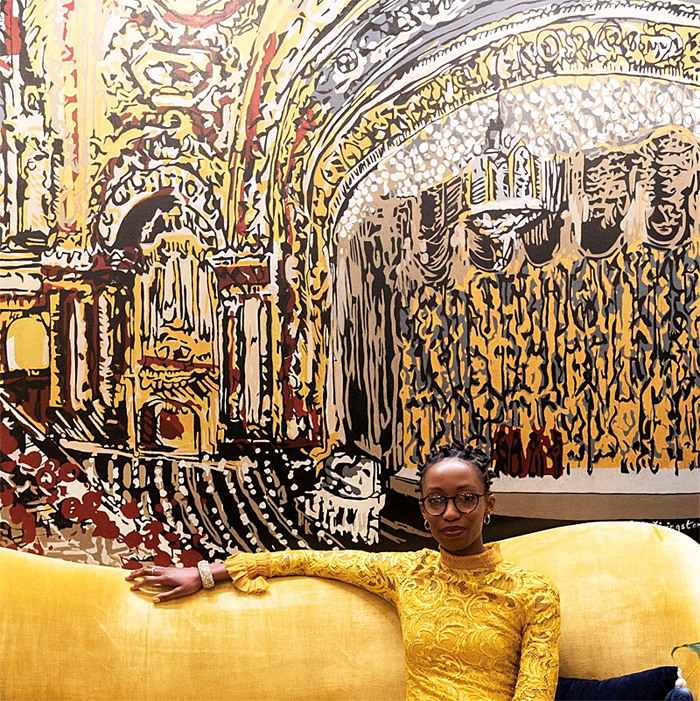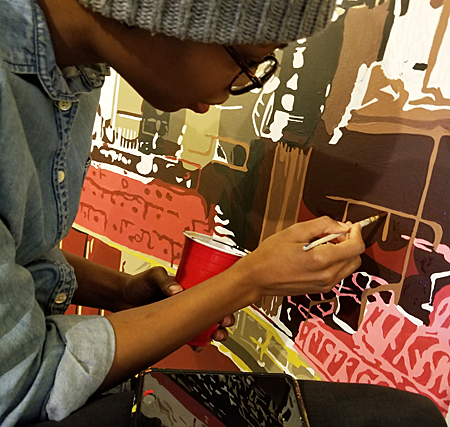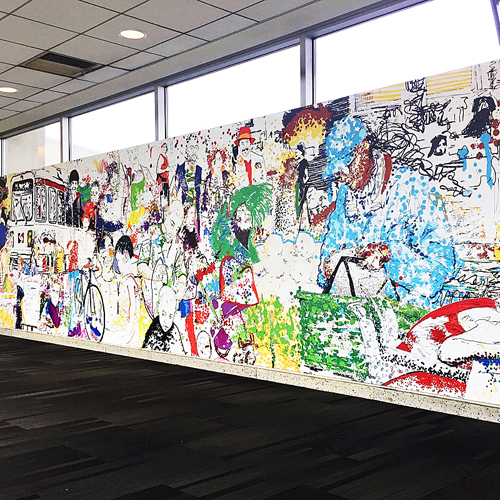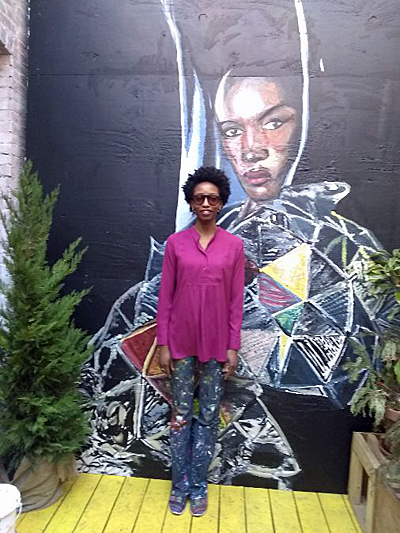Nile’s projects:
Virtual mural “Philly Rising, July 2020
Meet Nile:
Nile Livingston has a family history rooted in art and public service. Her grandfather, Walter R. Livingston, was a well-known Philadelphia architect who was a founder and charter member of the University Swim Club, the city’s first private integrated swim club, in 1964.
“I got started from seeing my grandfather’s drafts, materials around, art supplies,” said Livingston, “and my dad also drew. My parents were really encouraging.”

Livingston chose public art as her form of expression, and today is an artist-in-residence at the West Philadelphia Cultural Alliance/Paul Robeson House & Museum.
She has set up shop in the administrative building, an adjacent rowhouse that was purchased along with the Robeson house by Fran Aulston and the WPCA in 1994. Livingston first used the space as a studio for commissioned paintings, and that arrangement developed into her residency.
Livingston, whose first name is pronounced “Ny-elle,” is one of three artists-in-residence at the house. The others are singer Gordon Brown and African drummer Zumbi Soweto.
Livingston grew up and lives in West Philadelphia. She has worked the polls in the neighborhood at election time, and she and her family are members of the Walnut Hill Community Association. Her grandmother volunteered with United Way.
She got involved with the Robeson house after attending meetings here of the August Wilson and Beyond class, a joint partnership between WPCA and the University of Pennsylvania that examines the works of this famous African American writer.
Vernoca L. Michael, executive consultant for the house, got to know her from those sessions.
“I found out she was interested in working in the arts,” said Michael. “We have had, over time, persons who were designated as artists-in-residence, so I talked to her about being a potential artist-in-residence. In the meantime, she was able to get this particular project (and) she came and asked if she could use the space here.”
Livingston was hired to create four huge canvas murals – 7 feet by 7 feet – for a co-working space at 20th and Market Streets in Philadelphia. The works were commissioned by Convene Philadelphia, whose building was erected on the former site of the Mastbaum Theater.

The other murals depict Grace Baptist Church, from which Temple University was founded and whose building now serves as a multipurpose facility for concerts, theater and lectures; Polett Walk on Temple’s campus, and an interior view of the Academy of Music. Temple is renting two floors in the building.
Her mural for Convene were created to be hung in each hallway of the building. Each has a predominant color of gold, red, blue and green so visitors will know exactly where they are in the building.
When she got started with the Mastbaum mural, Livingston said, she could find no photographs of the stage view that she wanted. So, she stitched together several images.
“The people I’m working with are designers and they wanted to see something beautiful and theatrical,” she said. “They came up with the subject matter, but they gave me creative freedom with the style.”
And what is her style? Unfinished, the murals looked like specks of black paint with dabs of color but no form. The finished products, however, are very distinguishable.
“I don’t know what to call it exactly,” said Livingston. “I use Sharpie paint markers for the original drawings and each separate color you see is actually a separate piece of paper, a separate drawing I did. I scanned each drawing on the computer and then overlaid them in Photoshop and adjusted the colors.
“Maybe you can call it abstract.”
She has also completed a mural of the singer Grace Jones, which is on display at the Mission Taqueria restaurant throughout the spring. Her mural “Philly Jawn” can be seen in Terminal E at Philadelphia International Airport. A series of posters based on photographs of Philadelphia scenes overlaid with uplifting messages are on display for six months in the Terminal F Baggage Claim area. The latter were created in conjunction with LEADERSHIP Philadelphia and Mural Arts Philadelphia “with the goal of inspiring more passion,” she said.

Livingston says she doesn’t remember when she first started drawing, but an early journal pointed to one occasion.
“I was looking through an old journal,” she said. “I went to Powel (Elementary School) in preschool and our assignment was to draw what you think God look like or something like that. I remember looking through my journal and there were drawings from school assignments.”
Her drawing of God was “someone with big curly hair.”
She attended the Philadelphia High School for Creative and Performing Arts, and went on to Kutztown University, where he studied sculpture and metal fabrication and received a BA degree in studio art in 2010. “I had a clear idea of what I wanted to focus on in life. So, I think all my life I was an artist.”
A year later, Livingston worked with students through the Cecil B. Moore Recreation Center in North Philadelphia to create a mural as part of the Mural Arts Program. She and a friend solicited businesses to donate supplies.
The mural was painted on a wall at 22nd and Lehigh Avenue but the building was knocked down.
“Students helped me design a mural, and through that I continued onto the path of public arts as well as graphics design.”
Livingston wants to be active with the Paul Robeson House in the same way. “I definitely want to move into more community-based art, find out what the needs are of the neighborhood and involve them in the art-making process,” she said.
